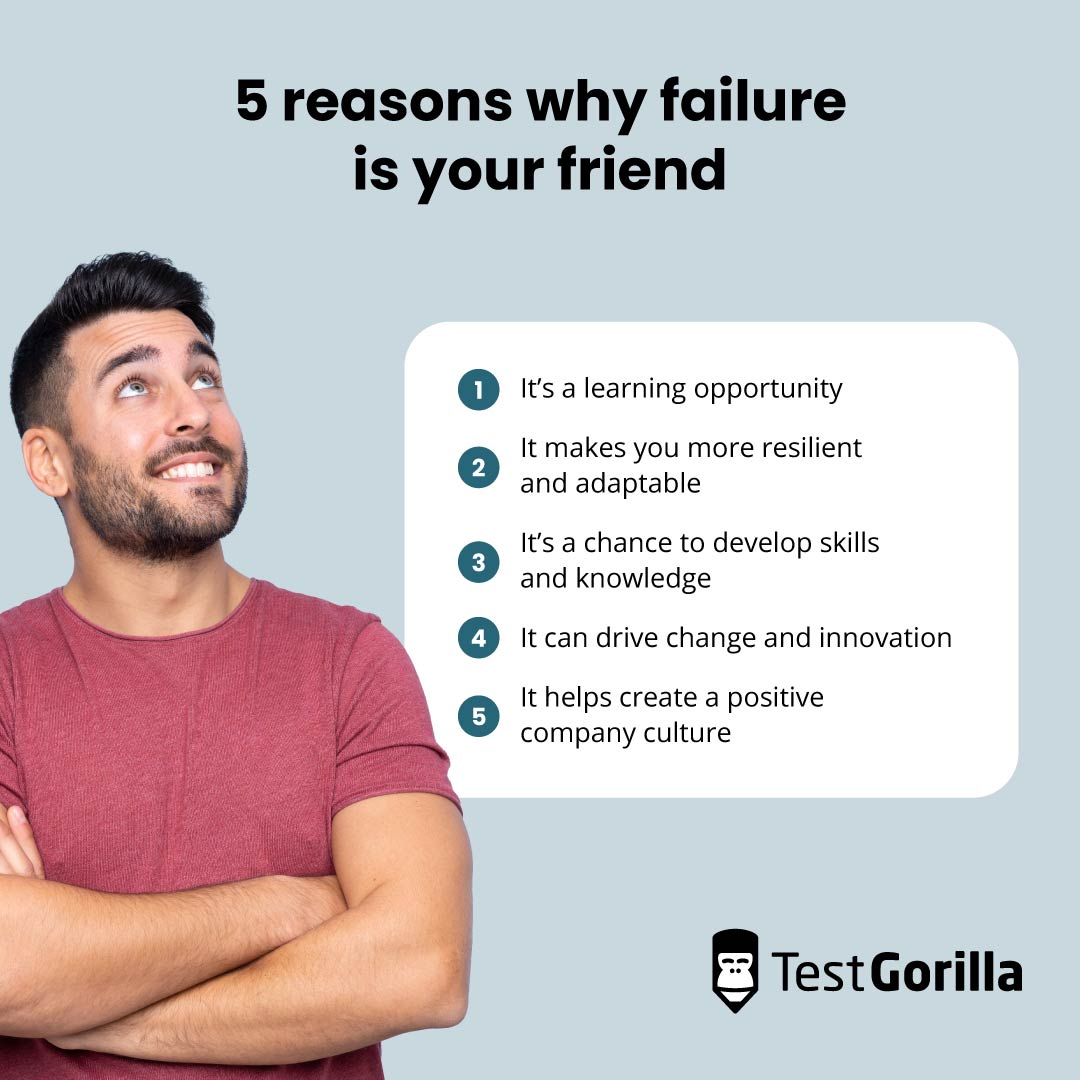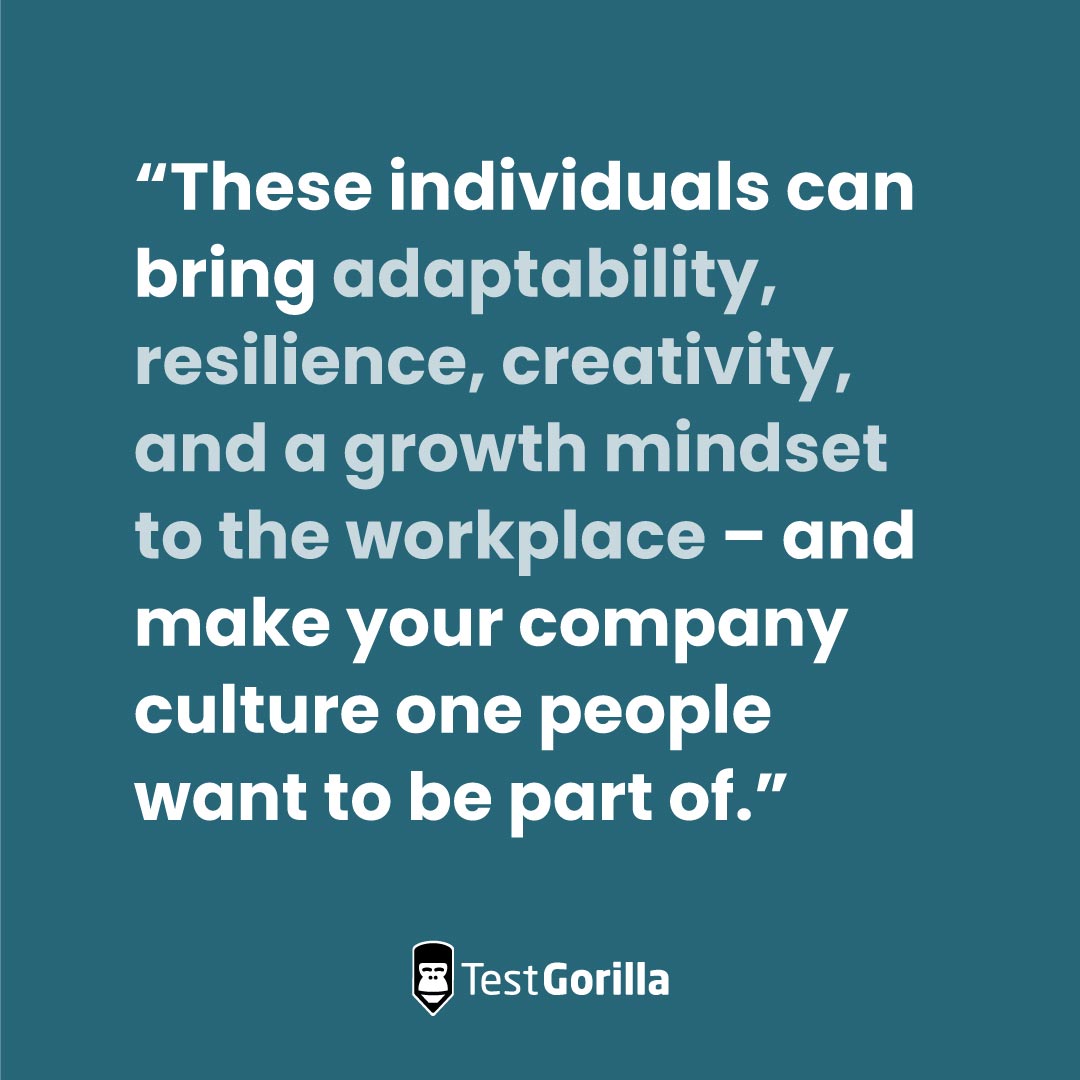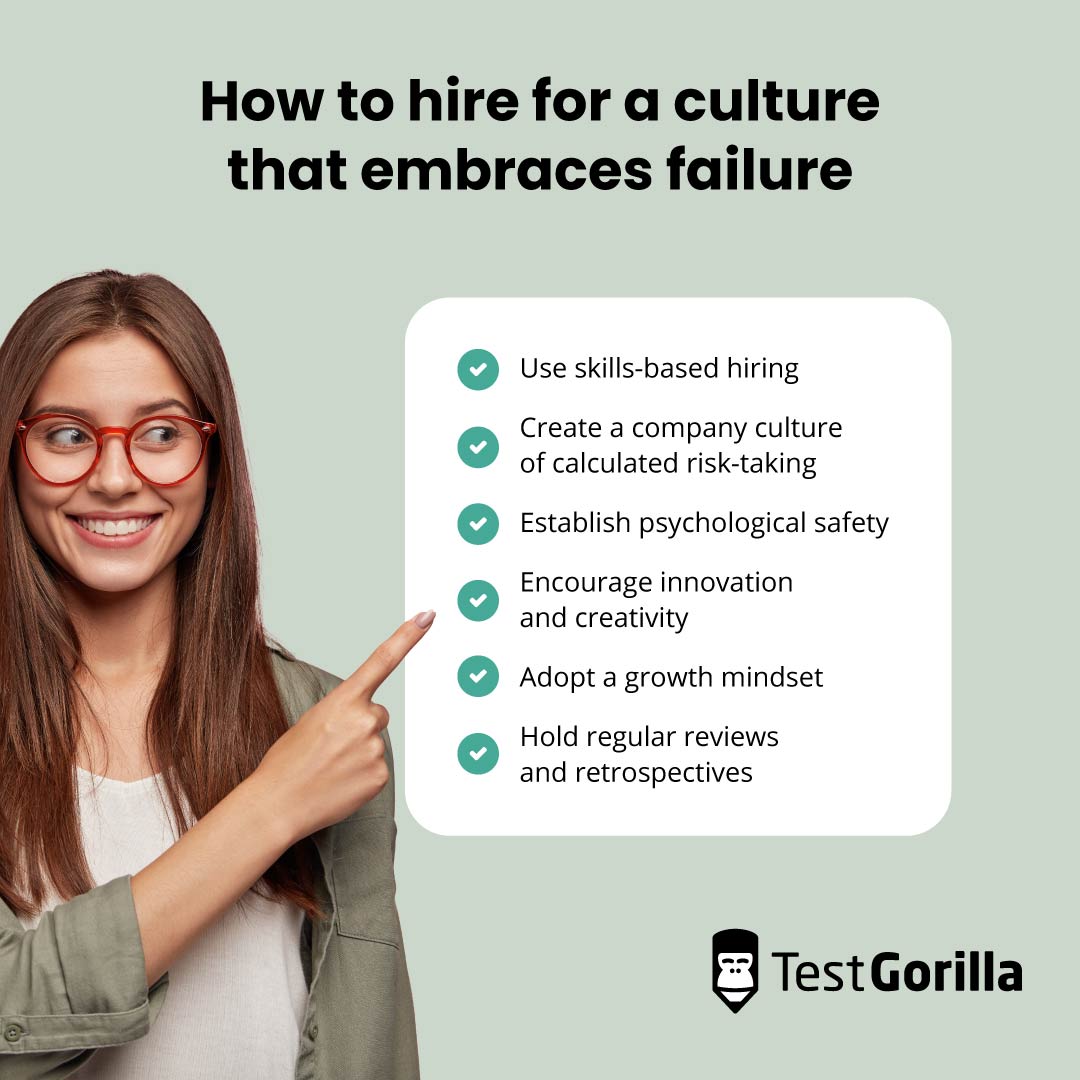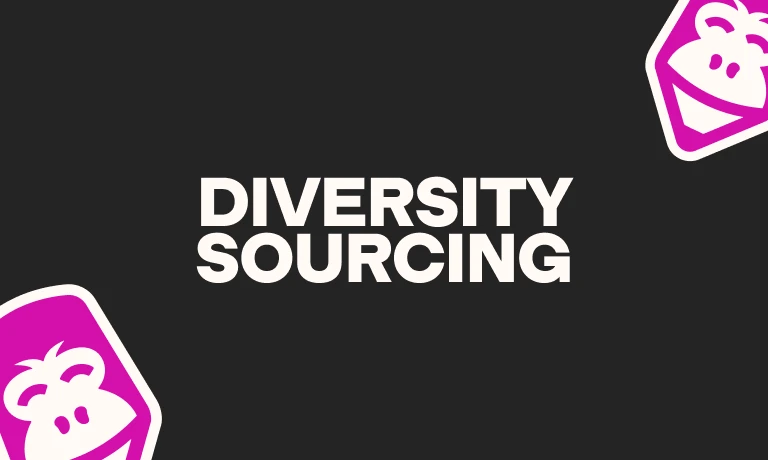After onboarding your newest hire, George, whose resume sparkled with prestigious degrees and a laundry list of impressive past employers, you're confident in his ability to thrive in your growing startup.
However, after a few months on the job, you realize something isn't quite right: George struggles to adapt to the company's collaborative culture and learn from team failures and mistakes. Deadlines are missed, team dynamics are strained, and morale begins to plummet.
You begin to realize that relying on resumes in your hiring process doesn't let you vet for behavioral and cultural alignment – like knowing how to fail.
To join the ranks and be a successful company, you need to seek out individuals with a balanced track record of both success and failure – because they have learned how to grow from mistakes and missteps.
In this post, we’ll explore how an environment where failure is seen as an opportunity – rather than a personal shortcoming – can benefit your employees and your business.
We’ll outline how to create a company culture that not only accepts but embraces failure as a shared learning opportunity and a chance to develop skills and become more resilient.
We'll also explain how to use talent assessments to develop the soft skills employees need to analyze situations, take calculated risks, see failure as a learning experience, and bounce back from it.
5 reasons why failure is your friend
From keeping your ego in check to motivating you to keep improving, failure has many benefits. Let's take a look at five of them in more depth.
1. It’s a learning opportunity
Unlike success, failure prompts you to closely examine what didn't work. This can give you valuable insights and perspectives you didn't have before, and help you significantly improve systems and processes. It can also help you develop a thicker skin, which helps make you more agile – and less attached to the fear of failure – in your decision making.
Additionally, by analyzing what went wrong, understanding the root causes, and figuring out how to rectify the situation, you can develop critical problem-solving skills – and apply them in the future.
Pro tip: When hiring, look for underdog candidates who have gaps in their resume because it's more likely they have experienced adversity and will be an asset to your company. Or, use talent assessment software to attract and hire more diverse candidates with a range of skills and experiences.
2. It makes you more resilient and adaptable
When you fail, you're forced to adapt. You and your team might need to change your strategies, tactics, or mindset to overcome the challenges that led to failure.
Failure also tests your resilience and determination. It teaches you to bounce back from setbacks, which is an essential quality for achieving long-term success. The more you face failure and persevere, the stronger your resilience becomes.
Forbes research suggests that resilient teams are healthier physically, emotionally, and mentally, which helps prevent burnout and stress in employees.[1] This can create a positive feedback loop of happy and healthy employees who burnout less often and are, therefore, more resilient.
3. It’s a chance to develop skills and knowledge
Although it's easy to blame failure on external factors that weren't in your control, it's also important to look inward and identify any potential areas of growth in your skills, knowledge, or experience.
When you take control of your side of things, it can also be easier to trust the success of the outcome. This is because encountering obstacles or making mistakes lets you pinpoint the specific skills or knowledge that would have helped you succeed. Therefore, the next time you make an attempt, you're more likely to get a positive outcome.
Failing also lets you learn from real-world situations and apply that knowledge in future endeavors. This type of learning is often more practical and memorable than theoretical study alone.
4. It can drive change and innovation
Failure often leads to innovative thinking. When your initial approach doesn't work, you're forced to explore new ideas and unconventional solutions, which can spark creativity and lead to breakthroughs.
Considering creative and analytical thinking remain the top two most important skills for workers in 2023, befriending failure could improve your ability to develop these critical skills – and give you a competitive edge.[2]
5. It helps create a positive company culture
A culture that accepts failure as a part of the learning process promotes a growth mindset among employees. They are more likely to view challenges as opportunities for personal and professional development, which can lead to higher job satisfaction and engagement.
Additionally, embracing failure promotes transparency and accountability within your organization. When you lead by example and encourage your people to admit mistakes and share their failures openly, it reduces fear and encourages honest communication.
This transparency can lead to better problem solving and collaboration, and help make your company culture one people want to be part of.
How to hire for a culture that embraces failure
In a key survey, 90% of chief executives admitted failure was their biggest fear.[3] Fear of failure can hold your business and your employees back because it can limit you from taking risks, trusting your team, and thinking creatively.
In six simple steps, here's how you can create a culture that embraces failure and become a resilient team that prioritizes continuous improvement:
1. Use skills-based hiring
To build a dynamic team with a growth mindset, you need to hire the right people. This means using skills-based hiring to test and measure essential skills that demonstrate a willingness to learn and an ability to fail.
For instance, consider using the following tests:
These tests can all help you understand if candidates, employees, and leaders have what it takes to fail or make mistakes and learn from them. This gives you a clearer picture of candidate-job alignment and their future success in the role and company.
According to our 2022 State of Skills-Based Hiring report, 72.1% of team members who were recruited via skills-based hiring were happy or very happy in their current roles. With a skills-based approach to hiring, you can recruit people who are more likely to love what they do and stick around longer. This lets you retain more employees – including their crucial knowledge and skills gained from failing – long-term.
2. Create a company culture of calculated risk-taking
According to executive career coach Tarah Keech: "If you start with a risk-taking culture and the mindset of moving towards a very specific or intentional outcome, then every mistake you make on the way is getting you one degree closer to that."
Therefore, it's important to celebrate calculated risk-taking as opposed to trying to anticipate or mitigate any possible risks that can happen. Attempting to peer into the future to prevent failure can distract you from the very real steps and goals you're trying to achieve in the present.
Here are some best practices to inspire your team to take conscious risks:
Establish clear guidelines and parameters. Define what constitutes taking a "calculated risk" and what "success" looks like within your organization. Outline acceptable levels of risk as well as any potential consequences. Tarah says, "If you don't have a clear definition of what success looks like then everything sort of feels like failure."
Lead by example. Leaders should demonstrate a willingness to take calculated risks themselves. When employees see leaders stepping out of their comfort zones, they are more likely to do the same.
Recognize and celebrate resilience. Give shoutouts to individuals or teams who demonstrate resilience in the face of setbacks and who actively apply lessons learned from failure. Use your dedicated Slack channel or your company newsletter to make it public.
Encourage cross-functional collaboration. Bring departments across your company together by uniting diverse perspectives and expertise into risk-taking processes.
Case study: Google Wave
When Google launched its online platform Google Wave in 2010, expectations were high. However, after only one year on the market, the platform tanked. In light of this failure and instead of making the team redundant, Google's Head of People Operations, Laszlo Bock, rewarded them.
In his book titled, Work Rules!, Bock even commented on this event saying: "They took a massive, calculated risk. And failed. So we rewarded them."
3. Establish psychological safety
Psychological safety means your people aren't afraid to speak up or be their authentic selves without fear of negative consequences. This helps employees feel comfortable taking calculated risks, admitting to failing or not knowing something, requesting help, and sharing their ideas. All of this can lead to more resilient, adaptable teams.
Here are some tips on how to create psychological safety at work:
Build trust. You can do this by consistently keeping commitments, maintaining confidentiality, and being reliable. Trust is the foundation of psychological safety.
Enable your people. Give employees autonomy and ownership over their work, and make sure they have all the resources and tools they need. Empowered individuals can be more likely to take risks and share their ideas.
Create an inclusive environment. Welcome diverse perspectives and backgrounds and celebrate differences to ensure everyone feels like they belong.
Offer training. Education on topics such as unconscious bias, empathy, and active listening can help employees better understand each other and work together effectively.
Encourage asking questions. Make it safe for employees to ask questions, even if they seem basic. Promote curiosity and exploration without judgment.
4. Encourage innovation and creativity
When you foster psychological safety at work, it means your team is also more likely to innovate and come up with creative solutions. This means you get a return on your investment: Research from McKinsey shows a strong correlation between creativity and superior financial performance.[4]
Therefore, highly innovative and creative teams are a good indicator of a company's overall ability to fail and bounce back with vengeance.
Here's how to get your teams to take their creative liberties:
Use talent assessments. Skills-based testing lets you measure soft and hard skills that more accurately convey a candidate's ability to innovate and be creative than traditional resumes. Talent assessments also increase your chances of hiring diverse employees with different backgrounds, skills, and experiences. This can lead to a wider range of perspectives, ideas, and creative output.
Host regular brainstorming sessions. Encourage your team to come together for collaborative brainstorming on projects, tasks, or team-building activities.
Dedicate creative time. Allocate time for employees to explore their own ideas and pet projects. Google's "20% time" is a famous example of this approach.
Organize innovation challenges. Create games or competitions within your team or organization. This can ignite friendly competition and creativity.
Recognize employees for innovative ideas. Reward your team for taking calculated risks that lead to positive outcomes. Celebrate successes and acknowledge efforts, even (especially?) if they end in failure.
5. Adopt a growth mindset
People with a growth mindset tend to embrace challenges, view failures as opportunities for growth, and see effort as a path to mastery. They believe they can develop their abilities and skills through hard work, dedication, and perseverance.
When everyone on your team thinks this way, you can collaborate better and inspire each other through shared successes. Team members with this mindset are also more supportive of each other's growth, which can lead to stronger relationships and a more positive work environment.
Here's how to encourage a positive and uplifting team atmosphere based on growth:
Encourage employees to set challenging yet achievable goals. Solid goals can push them out of their comfort zones and help them view any setbacks as opportunities for growth.
Promote effort over talent. Shift your focus from innate talent to the effort and perseverance required for success. Highlight examples of individuals who have achieved greatness through hard work, and use talent assessments to measure skills gained over time.
Encourage mentoring and coaching relationships. Personalized coaching or mentoring can provide guidance and support for individual and team growth.
Create a culture of publicly or privately celebrating failure. Share stories on Slack or in your daily team huddles about experiencing failure. This can help you identify the learning opportunities failure brings and keep everyone in a low-ego, high-growth mentality.
6. Hold regular reviews and retrospectives
Timely and transparent reflection on projects, individual or team performance, failures, and successes can yield important learnings.
Therefore, it's crucial to treat your failures as if they were investments in your growth and learning process. To do this, begin by asking yourself a variety of questions about the nature of the failure. This helps you peel back what really happened, "versus the narrative you've created around what happened," Tarah says.
"Often, we put our subjective thoughts out there as though they were objective facts. This is our emotional experience of that failure, not the failure itself."
Use the following questions to help you dive into your project reviews and failure retrospectives. Then, go over them with the people you failed with to better understand their experience.
What's the story you're telling about the failure? Is it really true?
What lessons did you learn?
What would you do differently next time?
What value can you extract from what you did learn?
Is there anything you need to make right?
What do you want to do next?
These types of questions will bring clarity to all the facets of your failure. This might include your ability to work with different people and personalities, where you're focusing your resources, "or that you don't actually care about X, Y, and Z line of research, or project, or company," Tarah says.
The best insights on HR and recruitment, delivered to your inbox.
Biweekly updates. No spam. Unsubscribe any time.
Making friends with failure: the key to resilient and adaptable teams
Strong companies recognize that failure is unavoidable, so they make the most out of failing by creating a culture around it. If they're taking a page from Google's book, they might even reward themselves for it.
In a world where change is constant and challenges are inevitable, embracing failure can be a powerful asset, driving your business toward greater achievements and lasting success.
Moreover, hiring individuals who embrace failure as a valuable learning experience is not just good for business; it's essential for long-term success. These individuals can bring adaptability, resilience, creativity, and a growth mindset to the workplace – and make your company culture one people want to be part of.
To hire for a culture that embraces failure:
Use skills-based hiring
Create a company culture of calculated risk-taking
Establish psychological safety
Encourage innovation and creativity
Adopt a growth mindset
Hold regular reviews and retrospectives
Once you've done this, you can continue using talent assessments to measure and develop the soft skills needed for your team to make failure both a positive experience and a springboard to success.
Build high-performing teams that bet on themselves. Talent assessments help develop the soft skills teams need to learn and grow from failure. |
Sources:
"Resilience: The Key To Future Business Success." (2020). Forbes. Retrieved September 13, 2023. https://www.forbes.com/sites/jimpurcell/2020/09/14/resilience-the-key-to-future-business-success/?sh=23188d495fde
"Future of Jobs Report 2023." (2023). World Economic Forum. Retrieved September 13, 2023. https://www3.weforum.org/docs/WEF_Future_of_Jobs_2023.pdf
"Findings from Our CEO Journey Study." (2018). Norwest. Retrieved September 13, 2023. https://www.nvp.com/blog/insights-norwests-2018-ceo-journey-study/
"Creating creatives." (n.d.) McKinsey Quarterly. Retrieved September 13, 2023. https://www.mckinsey.com/capabilities/people-and-organizational-performance/our-insights/five-fifty-creating-creatives
Related posts
You've scrolled this far
Why not try TestGorilla for free, and see what happens when you put skills first.





















